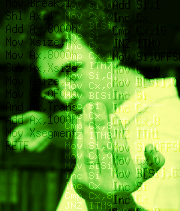 Pour éviter que Keen ne passe à travers les murs ou ne reste bloqué en bas d'une pente, les niveaux attribuent à chaque bloc de 16x16 pixels un ensemble de propriétés. C'est la technique des "tiles" bien connue de la plupart des lecteurs. Ce qui est particulier dans le moteur d'ID software, c'est la possibilité de définir séparément l'animation, la pente de sol, le comportement en tant que bloc spécial (valeur du bonus, couleur de la clé, etc.) et la polarité du mur.
Pour éviter que Keen ne passe à travers les murs ou ne reste bloqué en bas d'une pente, les niveaux attribuent à chaque bloc de 16x16 pixels un ensemble de propriétés. C'est la technique des "tiles" bien connue de la plupart des lecteurs. Ce qui est particulier dans le moteur d'ID software, c'est la possibilité de définir séparément l'animation, la pente de sol, le comportement en tant que bloc spécial (valeur du bonus, couleur de la clé, etc.) et la polarité du mur.
Plus fastidieux à définir que le simple remplissage en tant que bloc solide de mon éditeur de niveau, mais heureusement, dans Keen, il y a presque systématiquement correspondance entre graphisme et propriétés, et l'éditeur de niveau peut automatiser tout ce qui n'est pas passages secrets.
tinf. NORTHWALL, in the snippet above, is the offset to the array holding information about how the tile behave as a floor. Is it sloped ? can we move through if we're sliding down a pole ? tinf[NORTHWALL+*map] tells you that. And only that. If you'd like to know whether there's a bonus of some value, you should definitely check another "slice" of the tinf array. La notion de "polarité des murs" est intéressante. Lorsque le personnage se retrouve partiellement dans un mur, c'est cette polarité qui décide si Keen est repoussé vers la gauche ou vers la droite. On aura donc jamais de situation comparable au "zipping" des jeux NES où Megaman se met à traverser le niveau à vitesse super-sonique lorsqu'il rentre dans un mur simplement parce que les programmeurs se sont contenté de "si on est dans un bloc solide, on repousse Megaman sur le tile suivant". Evidemment, ça suppose que les murs font toujours au moins deux tiles de large.
La notion de "polarité des murs" est intéressante. Lorsque le personnage se retrouve partiellement dans un mur, c'est cette polarité qui décide si Keen est repoussé vers la gauche ou vers la droite. On aura donc jamais de situation comparable au "zipping" des jeux NES où Megaman se met à traverser le niveau à vitesse super-sonique lorsqu'il rentre dans un mur simplement parce que les programmeurs se sont contenté de "si on est dans un bloc solide, on repousse Megaman sur le tile suivant". Evidemment, ça suppose que les murs font toujours au moins deux tiles de large. |
| A Zipping technique in Megaman. Propelled at 1 tile/frame or so. |
cando() function.C'est intéressant de voir que ID software a choisi ici une technique radicalement opposée à celle d'Epic Megagames. Pour Jill of the Jungle et Xargon, Epic faisait en sorte que le personnage n'entre jamais dans des tiles qu'il ne peut pas traverser (grâce à la fonction "cando"). Pour Keen, think() peut potentiellement faire rentrer un personnage dans un mur, mais le déplacement via ClipToWalls() le repoussera automatiquement dans la bonne direction, sans risquer de se faire piéger par un demi-tour de dernière minute comme dans Mario Bros.




 Vote for your favourite post
Vote for your favourite post



No comments:
Post a Comment